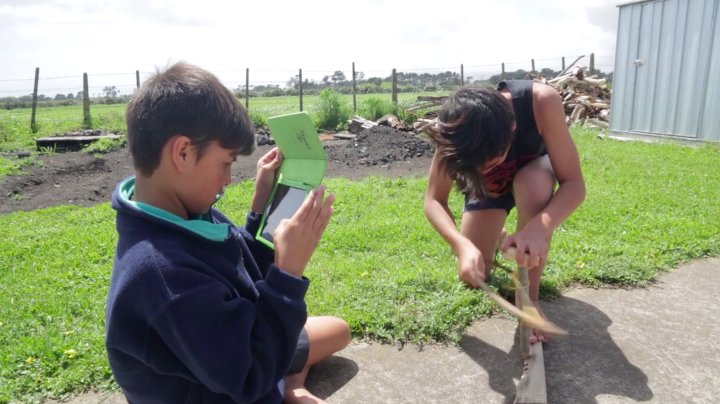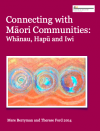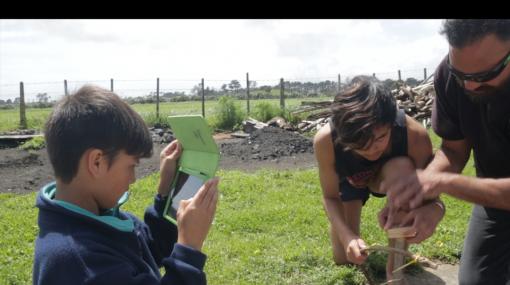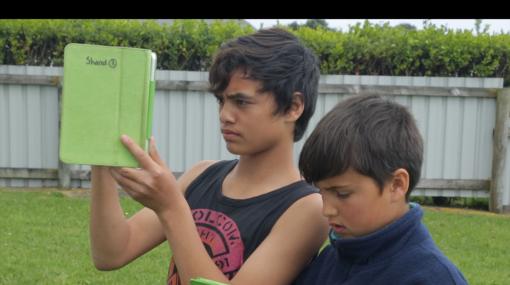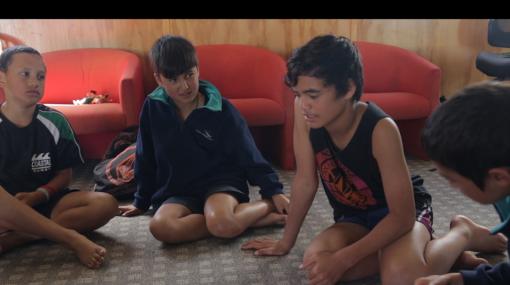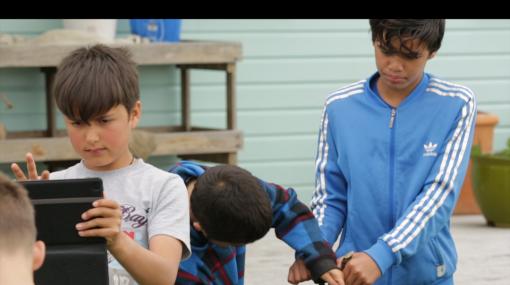Supporting place-based education with digital technologies
The objective of place-based education is to develop in learners a love of their environment, of the place where they are living, of its social history, of the bio-diversity that exists there, and of the way in which people have responded and continue to respond to their natural and social environments.
What is place-based education?
Placed-based education is an approach that takes a school's geographic location as a context for learning.
Place-based education can happen anywhere: In city streets or national parks; on the Marae; on beaches, rivers and lakes; on farms or in museums; on school campuses – wherever your inquiry takes you. Place-based education can help to localise your curriculum by giving students a sense of responsibility and affiliation for their surrounding environment, community and region.
"Place-based education is the process of using the local community and environment as a starting point to teach concepts in language arts, maths, social sciences and other subjects across the curriculum."
Place-based education in Aotearoa
In Aotearoa New Zealand, place-based education has a special role in connecting students with local Māori knowledge, histories, skills, techniques, and tikanga (values and customs). Place-based education can be a driver for re-examining the historical and social contexts of places in Aotearoa, especially from a kaupapa Māori perspective.
Place-based education and digital technologies
Location-based mapping tools, content development apps, and virtual tour creation tools are some of the ways through which you can capture, document, and share learning around place.
Learners can use digital technologies to highlight issues affecting their local area, to tell local narratives, and to remap local geography from the point of view of mana whenua, drawing attention to the places of significance.
More information about specific technologies to use with your students is in the navigation tabs.
Benefits for students
Place-based education can:
- strengthen a learner's identity and reinforce a sense of belonging and pride in their local environment
- help to deliver a culturally responsive curriculum
- develop expertise around digital technologies used to document and share place-based learning
- provide an authentic context for learning Te Reo Māori
- extend learning beyond the classroom; connect students and schools with communities
- improve outcomes for Māori learners by making curriculum content relevant to their language, culture and identity
- encourage a sense of stewardship over the local environment
- build relationships between schools and manua whenua
- equip students with skills used by professionals working in the fields of community development and environmental science.
Key resources
Pūtātara
Toolkit for supporting NZ schools develop place-based learning opportunities.Hītori Māori – Maori history
This resource, written for teachers in New Zealand primary schools, has an emphasis on local history and building collaborative relationships with iwi and hapū.
By focusing on local stories, place-based education can show how past events have shaped a student's own life and surroundings.
By understanding the histories of others, learners can challenge their assumptions, re-consider accepted world-views, and understand their own environment from alternative points of view.
Place-based education is learning "through storytelling, through pepeha, through kōrero; through being on the marae and exchanging views about what's going on there, and the histories that belong to that place."
Local histories - a student’s perspective
Arapeta Latus, a senior student at Whanganui City College, talks about the importance of hearing local history from local people, and visiting sites of significance where possible. Video source: Hītori Māori –Maori history
Getting started
- Start with what you know, then work backwards. How has your neighbourhood changed overtime?
- Be willing to step back and listen to your students, acknowledging a special place for tangata whenua.
- Engage whānau and the wider community: What kind of local knowledge is ready to be shared by parents?
- Build connections with local iwi and hapū.
- Partner up with other schools.
- Leverage local assets like museums, libraries, parks, public spaces, and businesses.
- Develop local resources that reflect local history.
Māori Maps
Find your way to the tribal marae of Aotearoa New Zealand – through maps, information and photographs – through the digital gateway of Māori Maps.
Connecting with Māori Communities: Whānau, Hapū, and Iwi
This resource outlines key messages from research and literature that relate to schools connecting with their Māori communities, including whānau, hapū, and iwi.
Share your place-based stories with digital tools
Publish your place-based stories using digital tools. Create content that bring locations to life by incorporating images, media, and interactivity. Use the power of web apps to take 'social action'. Share content on social media platforms like Instagram, Twitter, and Facebook.
Storymap
Helps you tell web stories that highlight the locations of a series of events. Create an interactive "storymap" that builds narrative around places.
ThingLink
Thinglink is a media annotation tool. Create interactive maps, or VR experiences with annotated 360 degree photos of your field trips.
Canva timelines
Place local events along a timeline infographic with Canva.
Adobe spark
Publishing tool for making snappy videos, graphics, and web pages.
Anchor
Create sharable podcasts.
Infogram
Create an engaging graphic to represent your story data.
Steller
A web app that helps you create multimedia stories that can be easily shared on social media platforms.
School stories, readings, resources
Wairakei School – Working in partnership with Ngāti Tūwharetoa
Schools in the Taupō area, including Wairakei School, have worked in partnership with Ngāti Tūwharetoa to ensure students learn about their iwi, its history, places, and stories.
Christine Jessop, sabbatical report
This report, by Christine Jessop from Forest Lake school, investigates what an effective culturally responsive approach to the implementation of New Zealand Curriculum and Te Marautanga o Aotearoa might look like.
Different perspectives emerge as students research first encounters
Students at a Marlborough school are hearing a different side of their local history that includes first encounters between migrants and Māori and how it was experienced by local Iwi.
Celebrating local stories
Teachers and students at Te Mata kindergarten connect with Ngāti Kahungunu members for learning based on local legends.
"We’ve all experienced the power of place: those moments when we’re immersed deeply in experiencing the world around us and what’s happening there is real and meaningful."
When students are immersed in an outdoor learning environment, their work becomes real and immediate in a way that is different from classroom-based learning.
Use field trips to find authentic, place-based contexts for achieving a range of curriculum goals.
- Find appropriate outdoor settings in your local area for exploring curriculum goals and student inquiry.
- Use digital mapping tools and virtual field trip technology to document and share learning.
- Connect with local guides, make contact with mana whenua, and seek mentorship from community members with local knowledge and expertise.
The importance of field trips
Kirsten Erasmus and Johnny Horrax, history teachers from Aurora College, talk about a Māori history field trip around sites of significance in Southland. Video source: Hītori Māori –Maori history
Before you go
Choose a site that offers the exploration of a range of curriculum and inquiry goals, including maths, science, Te Reo Māori, social studies, and literacy. Go somewhere that fosters deeper learning about your school's and students' local context.
Connect with mana whenua – gain the knowledge of local guides
"Every community has experts who can inspire your students’ historical thinking, provide information, and add emotional impact to historical events. You can choose to invite experts to the classroom or to visit them at an historic site so that students are able to relate events to where they took place."
Prepare
Gather equipment and resources, pre-teach place-specific terminology and concepts; discuss learning goals.
While there
Guide observations and document the field trip using a range of digital tools.
After
Follow up inquiry goals in the classroom, collate evidence and share learning using digital tools.
"Given the popularity and practise of pepeha among kaupapa Māori pupils, how familiar are they with the actual discrete landscape features mentioned in the pepeha; e.g. do they know where their mountains ares? Have they visited them?"
Cultural mapping
Cultural mapping is a way of putting culturally significant information onto a digital map.
Cultural mapping can challenge colonisation processes by remapping locations according to the perspectives of local people.
Today, with user-driven mapping tools like Google MyMaps, cartography has democratised, placing the power to define a landscape into the hands of those most connected to it.
Video: Ngāi Tahu's atlas project
Key players involved in Ngāi Tahu's ambitious Atlas project discuss the ability for modern mapping technology to help reclaim and communicate the significance of place.
Cultural mapping examples
Ngāi Tahu's atlas project
The Ngāi Tahu Cultural Mapping Project, is dedicated to mapping the traditional place names and associated stories within the Ngāi Tahu rohe (tribal area). Visit our Ngāi Tahu Atlas to see over 1,000 traditional place names in Te Waipounamu.
Google lends a hand to help preserve Maori culture
This TV1 news report reveals how Google Earth is helping East Cape tribe Te Aitanga A Hauiti by lending them some gear usually associated with Street View, so they can use data mapping technology to culturally map their local area.
Mapping Tonga: Bringing Google Street View to the Pacific Kingdom
In this short documentary, Tania Wolfgramm works with Google to map her homeland: a country of 169 islands.
Map and share your field trips with digital mapping tools
With MyMaps, students become cartographers of their local area. MyMaps gives students the power to define / redefine a place on Google Earth by adding self-discovered landmarks and points of significance, and place names that may have been overlooked by official cartographers. They can create interactive journeys by annotating maps with photos they've taken, videos, or written explanations.
MyMaps are shareable, so students can collaborate in groups or with the entire class on building their localised map. MyMaps has a range of options for sharing maps with a wider audience: students can embed their maps on a website or social media, set sharing to public or viewable only to specific people.
Play, view and share your VR tours on Google Expeditions
Expeditions
This virtual field trip app lets users view VR tours and augmented reality on phones and tablets.
izi.Travel
Students can use this free app to create and share location-specific audio guides. The audio guides work with location services on your phone, allowing you to receive site-specific audio information wherever you are, as long as you have a data connection.
Virtual field trips
When physical locations are out of reach, do a virtual field trip to explore curriculum goals. Make inaccessible places accessible for your students using digital tools.
LEARNZ - Map my waahi
LEARNZ's recent virtual field trip explored mapping technology, whakapapa, and places in New Zealand. It is one example of the multi-faceted, online place-based learning experiences they offer to teachers and students in real time.
Expeditions
Extend your classroom beyond its four walls with these global VR field trips.
The environment surrounding a school can offer rich learning opportunities that can't be reproduced within the walls of the classroom. Local settings provide authentic, hands-on contexts for achieving a range of curriculum goals.
Questions to ask:
- What's going on in the community?
- What natural features, flora, and fauna are defining characteristics of your community? What do they mean to different members of the community?
- What problems are there – who or what in our environment is at risk? Can we solve them?
- Which local people and/or organisations can you collaborate with to help students actively contribute to their local environment?
- How can our learning foster a sense of kaitiakitanga (taking care of the environment)?
Using social media to share place-based learning
- Use social media to share information on your place-based projects, build relationships beyond the classroom, develop networks around your interests and activities, and engage your community.
- Form a social media strategy that addresses your target audience, objectives, and the functionality of various social media platforms.
- Model guidelines for appropriate use and behaviour on social media.
More information »
Using social media to connect with your community
This guide on Enabling e-Learning offers schools starting points for using social media with their communities.
Exploring the local environment as a context for learning
Use outdoor learning opportunities to strengthen:
- a students' sense of responsibility for the local environment and community
- STEM learning – gather data, take measurements, do surveys
- project-based learning – collaborate and problem-solve in real-world contexts
- real-world connections – form partnerships with experts, scientists, and stewards from appropriate environmental agencies and groups.
School stories
Menzies College – Localised learning at Mimihau Stream
Students investigated whether a local water source – Mimihau Stream – was truly a "dead waterway" as reported by various fishing authorities.
Learning locally – Connecting kids to their community
More localised curriculum stories on The New Zealand Curriculum Online.
Place-based learning on Edutopia
School stories and tips from educators on how to connect with local experts, form partnerships, and create exceptional place-based learning experiences.
Promise of place: Stories from the field
This US-based website contains teaching resources, school stories, and guides around place-based education.
Sourcing local environmental knowledge on the web
These web resources are possible entry points for projects with an environmental science / conservation focus.
Department of Conservation:Conservation education
Find resources to support conservation teaching and learning, and DOC supported education programmes you can get involved in.
Science learning hub
This web resource, produced by the University of Waikato, contains articles, stories, and teacher PLD that integrates environmental science, kaupapa Māori, and place-based learning.
NIWA
The National Institute of Water and Atmospheric Research is involved in a number of marine and land-based educational programmes involving schools in New Zealand.
These Snapshots of learning provide examples and ideas used by schools.
Sorry, no items found.
Sorry, no items found.
Readings
Place-based education: Catering for curriculum, culture and community
Wally Penetito's article discusses place-based education and its potential role in localising New Zealand's curriculum.
Place-based education: Connecting classroom and community
David Sobel is a US-based education writer working extensively in the field of place-based education.
Christine Jessop, sabbatical report
This report, by Christine Jessop from Forest Lake school, investigates what an effective culturally responsive approach to the implementation of the New Zealand Curriculum and Te Marautanga o Aotearoa might look like.
What is place-based education and why does it matter?
This resource by Getting Smart gives a helpful overview of the principles and practices driving place-based education.
Resources
Key resources
Hītori Māori – Maori history
This resource, written for teachers in New Zealand primary schools, has an emphasis on local history and building collaborative relationships with iwi and hapū.
Learning locally – Connecting kids to their community
This curriculum online blog offers some ideas, stories, and questions to help your students “learn locally”.
Uncovering local histories: Stories
Wairakei School – Working in partnership with Ngāti Tūwharetoa
Schools in the Taupō area, including Wairakei School, have worked in partnership with Ngāti Tūwharetoa to ensure students learn about their iwi, its history, places, and stories.
Different perspectives emerge as students research first encounters
Students at a Marlborough school are hearing a different side of their local history that includes first encounters between migrants and Māori and how it was experienced by local Iwi.
Celebrating local stories
Teachers and students at Te Mata kindergarten connect with Ngāti Kahungunu members to do learning based on local legends.
Cultural mapping: Stories
Kā Huru Manu
The Ngāi Tahu Cultural Mapping Project, is dedicated to mapping the traditional place names and associated stories within the Ngāi Tahu rohe (tribal area). Visit our Ngāi Tahu Atlas to see over 1,000 traditional place names in Te Waipounamu.
Google lends a hand to help preserve Maori culture
This TV1 news report reveals how Google Earth is helping East Cape tribe Te Aitanga A Hauiti by lending them some gear usually associated with Street View, so they can use data mapping technology to culturally map their local area.
Mapping Tonga: Bringing Google Street View to the Pacific Kingdom
In this short documentary, Tania Wolfgramm works with Google to map her homeland: a country of 169 islands.
Connecting with mana whenua
Māori Maps
Find your way to the tribal marae of Aotearoa New Zealand – through maps, information and photographs – through the digital gateway of Māori Maps.
Connecting with Māori Communities: Whānau, Hapū, and Iwi
This resource outlines key messages from research and literature that relate to schools connecting with their Māori communities, including whānau, hapū, and iwi.
Content development tools
Storymap
Helps you tell web stories that highlight the locations of a series of events. Create an interactive "storymap" that builds narrative around places.
ThingLink
Thinglink is a media annotation tool. Create interactive maps, or VR experiences with annotated 360 degree photos of your field trips.
Canva timelines
Place local events along a stylish timeline infographic with Canva.
Adobe spark
Publishing tool; users can make snappy videos, graphics, and web pages.
Anchor
Create sharable podcasts.
Infogram
Create an engaging graphic to represent your story data.
Steller
A web app that helps you create multimedia stories that can be easily shared on social media platforms.
Cultural mapping: Digital tools
MyMaps are shareable, so students can collaborate in groups or with the entire class on building their localised map. MyMaps has a range of options for sharing maps with a wider audience: students can embed their maps on a website or social media, set sharing to public or viewable only to specific people.
izi.Travel
Students can use this free app to create and share location-specific audio guides.
Virtual field trips
LEARNZ - Map my waahi
LEARNZ's recent virtual field trip explored mapping technology, whakapapa, and places in New Zealand. It was one example of the multi-faceted, online place-based learning experiences they offer to teachers and students in real time.
Expeditions
Extend your classroom beyond its four walls with these global VR field trips.
Local environments as a context for learning: School stories
Menzies College – Localised learning at Mimihau Stream
Students investigated whether a local water source – Mimihau Stream – was truly a "dead waterway" as reported by various fishing authorities.
Learning locally – Connecting kids to their community
More localised curriculum stories on The New Zealand Curriculum online
Place-based learning on Edutopia
A range of school stories and tips from educators on how to connect with local experts, form partnerships, and create exceptional place-based learning experiences.
Promise of place: Stories from the field
This US-based website contains teaching resources, school stories, and guides around place-based education
Sourcing local environmental knowledge on the web
Consider these web resources as possible entry points for projects with an environmental science / conservation focus.
DOC:Conservation education
Find resources to support conservation teaching and learning, and DOC supported education programmes you can get involved in.
Science learning hub
This web resource, produced by the University of Waikato, contains articles, stories, and teacher PLD on content that integrates environmental science, kaupapa Māori, and place-based learning content.
NIWA
The National Institute of Water and Atmospheric Research is involved in a number of marine and land-based educational programmes involving schools in New Zealand.
